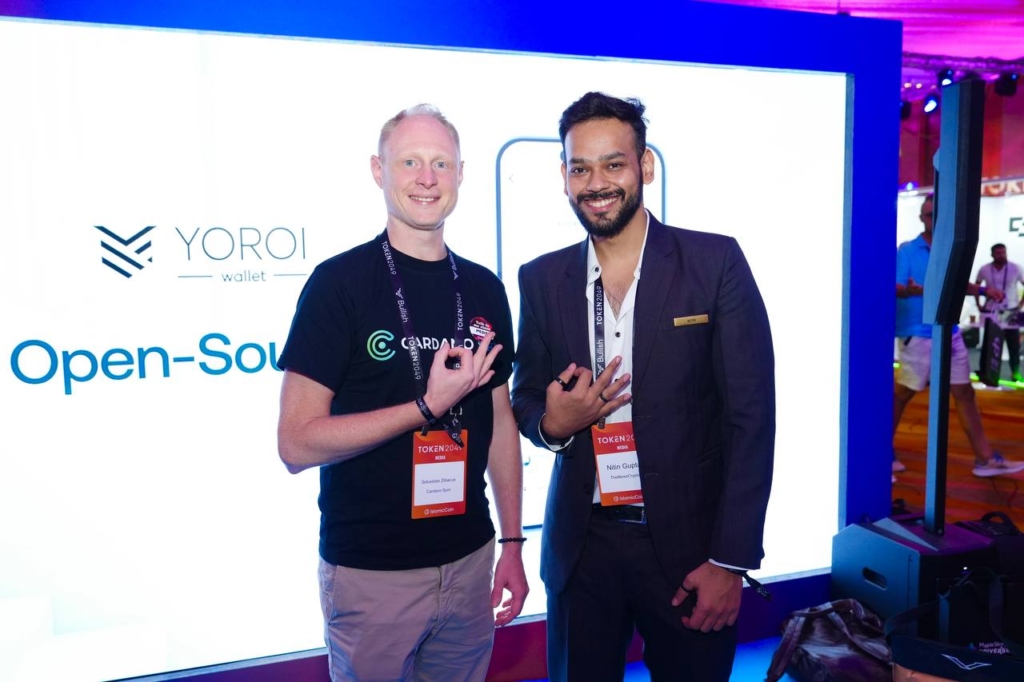The Web3 space is hinting at its entry into a decade of bullish transformation, evolving from being perceived as a mere buzzword to an innovation with higher utility. Key players in the industry are aiming to turbocharge the expansion and adoption of this revolutionary iteration of the Internet.
TheNewsCrypto sat down with Sebastian Zilliacus, Managing Director at EMURGO, discussing the pivotal role of Cardano Spot in driving Web3 adoption. He shares exclusive insights on Cardano’s unique approach to interoperability, and how EMURGO fosters blockchain education and community engagement.

In your view, how far has Web3 progressed as the next frontier of the internet? Can you highlight the role of Cardano in boosting Web3 adoption?
Sebastian Zilliacus (SZ): Web3 represents the vision of a decentralized internet, offering users unprecedented control over their online experiences. It champions ownership, censorship resistance, and the elimination of intermediaries in various applications and services.
The journey of Web3 began approximately six years ago, gaining momentum alongside the emergence of decentralized applications (DApps). This space has evolved significantly, with tens of thousands of DApps transforming numerous sectors, including payments, exchanges, lending, banking, financial services, art, music, gaming, and even distributed physical infrastructure.
Decentralized exchanges (DEXs) have facilitated trillions of dollars in transactions. At the same time, lending and borrowing protocols have enabled hundreds of billions of dollars in loans without the need for traditional underwriting banks. The Web3 ecosystem now boasts over 10 million monthly active users, showcasing remarkable growth.
In this exciting landscape, Cardano stands out as a formidable contributor to the advancement of Web3 adoption. Cardano offers a secure and appealing platform for developing applications, mainly drawing interest from enterprises and security-focused users. Notable projects like Book.io and Nucast leverage Cardano’s infrastructure to tokenize physical items like books and music as NFTs, broadening the potential user base and use cases.
Furthermore, Cardano is committed to addressing real-world challenges in developing countries across Asia and Africa. Initiatives such as World Mobile’s distributed local internet and Empowa’s rent-to-own property solutions exemplify Cardano’s dedication to empowering underserved populations with transformative opportunities. Cardano’s approach to solving real-world problems sets it apart from the broader crypto ecosystem.
In summary, Web3 has made significant strides, with countless DApps reshaping industries and attracting a growing user base. Cardano’s role in this transformation is noteworthy, providing a secure and versatile platform for developers, fostering inclusivity through projects targeting developing regions, and demonstrating a unique approach within the crypto landscape. Together, Web3 and Cardano are forging the path toward a decentralized and empowered digital future.
How is Cardano Spot designed to enhance community engagement and foster collaboration among ecosystem participants?
SZ: Cardano Spot is the first all-in-one social media platform for everything Cardano. Here Cardano fans and supporters come together. It’s designed to make it easy for people to find out what’s happening with Cardano and learn about it. Not only do web3 individuals highly value our product but we are also helping web2 businesses and individuals to join their web3 journey with us by sharing the knowledge and expertise about Cardano.
Talking about Cardano Spot as a product we have a bunch of valuable among the community features. Community Hub Page is one of them: here people from all over the world can talk about Cardano, they can share their thoughts, and ideas, and get to know each other. We also have a News Feed Page — a place where you can read deep-dive articles, the latest reports, interviews, and updates to know more about the ecosystem. We’ve gathered here guides, and tutorials to help you understand Cardano better.
We also believe in being inclusive, which means we welcome everyone. We celebrate the different projects within the Cardano Library Page and the ideas around it. We don’t just show these Cardano projects, we make them stand out so that people can see and support them.
We appreciate and recognize those who contribute, whether it’s by writing code like Cardano developers, creating an article like Cardano creators, leaving a message in a Community Hub or just being enthusiastic. Every little bit helps. We also create opportunities for people to work together. We organize events like meet and greet sessions, Twitter spaces, Live streams, and AMAs. We are looking for partnerships, and are happy to encourage new ideas within the community.
In short, Cardano Spot is a place where everyone can come to learn, share, and be part of the Cardano community. We’re here to make Cardano better and more accessible to everyone. For those who are familiar with Web3 and for the people who are only getting acquainted with it.
How distinct is Cardano’s approach to interoperability, incorporating solutions like cross-chain communication protocols and blockchain bridges?
SZ: Cardano’s vision of interoperability goes beyond technical solutions. It’s about creating an open and inclusive blockchain ecosystem where diverse networks can seamlessly interact and cooperate. For blockchain technology to reach its full potential, it must harmoniously integrate with other networks and assets. Its unique approach involves the development of cross-chain communication protocols and blockchain bridges. These mechanisms act as vital connectors, enabling the smooth flow of assets, data, and information across different blockchain networks.
Moreover, Cardano is deeply committed to open standards and collaboration within the blockchain space. We actively engage with other projects and platforms, aiming to establish universal standards that enhance interoperability. This collaborative approach is positioning Cardano as a driving force in advancing interoperability within the blockchain sphere.
Elliptic Curve Cryptography (ECC) has emerged as the predominant choice for crafting cryptographic protocols and ensuring the security of applications. ECC offers a comparable level of security to alternative methods but excels in efficiency by employing shorter keys and signatures. Within the realm of elliptic curves, one notable curve is Standards for Efficient Cryptography (SECP), with SECP256k1 being a prominent example. This curve is widely adopted by various blockchains, including Bitcoin, Ethereum, and Binance Chain, to implement public key cryptography. This involves the use of a key pair, consisting of a public key and a private key, to authenticate transaction signatures.
Following the integration of new cryptographic primitives, Plutus will gain the capability to seamlessly validate transactions from other blockchains using the Elliptic Curve Digital Signature Algorithm (ECDSA) and Schnorr standards. Meanwhile, the Milkomeda protocol offers EVM compatibility on Cardano. Lastly, I would add that interoperability is an industry-wide objective, not only a Cardano objective.
What challenges has Cardano faced while integrating Web3 projects, and how has EMURGO contributed to overcoming them?
SZ: Many Web3 projects demand a profound understanding of Cardano’s capabilities and potential. EMURGO has taken significant steps in educating newbies, developers, traders, enthusiasts, etc. about Cardano’s strengths and possibilities within the Web3 ecosystem. Additionally, the integration of Web3 projects often presents intricate technical challenges, so EMURGO’s blockchain expertise has proven invaluable in offering technical guidance and aiding project teams, ensuring a seamless integration process.
Equally crucial both for EMURGO and Cardano Spot is the establishment of a collaborative and supportive community for successful Web3 integrations. Our dedication to community engagement has nurtured a sense of cohesion among diverse projects, fostering collaboration and the sharing of knowledge.
What I would also like to highlight is that EMURGO’s investments are strategically spread across various domains within the blockchain and crypto space. Firstly, we actively support and invest in projects within the Cardano ecosystem, promoting growth and innovation. These investments fuel the development of decentralized applications (DApps), DeFi solutions, and NFT platforms, enriching Cardano’s ecosystem.
Beyond Cardano, EMURGO looks to the broader blockchain landscape. We seek opportunities in projects transitioning from Web2 to Web3, which harness blockchain technology to revolutionize industries. We are open to investments in projects from other blockchain networks, emphasizing the importance of cross-chain interoperability and collaboration.
By diversifying the investments, EMURGO contributes to the overall advancement of blockchain technology and its adoption across various sectors, accelerating the shift toward a decentralized future.
Right education aids in propelling adoption, and EMURGO aligns with this goal. How effective are Web3 players, including EMURGO, in educating the community about blockchain technology to drive adoption?
SZ: The effectiveness of Web3 players in educating the community about blockchain technology can vary. At Cardano Spot, we have a community-centric approach that focuses on content quality, accessibility, engagement, and continuous improvement. We aim to achieve the mission of promoting blockchain adoption through education. We focus on creating a global community hub by localizing our content.
We collaborate with Cardano native projects, educational platforms, and media businesses, providing awareness efforts. We hold hackathons and several content competitions, including tracking the number of participants, the knowledge gained, and the practical applications of blockchain technology by the community.
Moreover, EMURGO Academy has already been educating developers and decentralized finance (DeFi) professionals. The Academy offers the Cardano Solutions Architect (CSA) program for emerging developers. This program empowers developers to brainstorm, design, and create potential commercial applications for their startup ventures. Expanding upon the foundation provided by the Cardano Developer Professional program, this initiative centers on an in-depth exploration of use-case analysis, token economics, and related concepts.
As the Managing Director of the Media Division at EMURGO, could you provide insight into upcoming EMURGO and Cardano collaborative projects or initiatives?
SZ: At the moment we are heavily involved in the decentralization of Cardano. Voltaire is the final building era of the Cardano roadmap. From the beginning, Cardano’s development has been divided into several eras with each focusing on a different part of its technology.
The Voltaire era deals with its governance by the community and decentralization of the network.
The first steps in the discussion about Cardano’s future governance are underway with the community as the focus with support from EMURGO, Input Output Global, and Cardano Foundation through CIP-1694 workshops, constitution, and liquid democracy. Intersect was recently launched, which is the Cardano MBO.
Once Voltaire is in motion, the Cardano community will go from a passive watcher to an active entity when it comes to decision-making and steering of Cardano as a whole. The network will have a first-of-its-kind blockchain constitution meant to transparently and fairly rule over a decentralized network of community members.
What are the upcoming big plans that are exclusive to Cardano?
SZ: Certainly, when we look ahead to the next decade, Cardano’s future unfolds with a comprehensive vision spanning various dimensions. A pivotal facet of this vision is the drive for mass adoption. Over the next ten years, Cardano seeks to position itself as a global financial and social operating system, serving individuals, businesses, governments, and institutions on a global scale.
One of the defining elements of Cardano’s future is the dynamic growth of DeFi and its transformative influence on finance. We anticipate a wave of innovation and expansion in the DeFi arena within the Cardano ecosystem, making financial services more accessible and inclusive for all.
The integration of smart contracts into Cardano’s framework will open up a world of possibilities, nurturing a vibrant ecosystem of DApps spanning diverse sectors. From financial services to healthcare, supply chain management to entertainment, smart contracts will revolutionize interactions and transactions.
In the coming years, we anticipate forging deeper partnerships with governments, educational institutions, and enterprises worldwide, fostering collaborative research, development, and real-world applications.
Educational and research initiatives will empower the next generation of blockchain developers and researchers, bolstering the ecosystem’s strength. Community expansion will remain a central theme, with community-driven projects and initiatives driving innovation and outreach.
Lastly, Cardano’s dedication to social impact projects remains unwavering. These endeavors will continue to address real-world challenges in areas such as identity management, voting systems, and supply chain transparency.
What advice will you give emerging projects for effectively building a strong community?
SZ: As an emerging project looking to establish a robust community, there are several key principles to consider. Firstly, transparency in their project’s roadmap is essential. Clearly articulating their objectives, milestones, and the path they plan to take instills trust and confidence in a community. It shows them that they have a well-thought-out plan and are committed to achieving the goals.
Secondly, authenticity. Their intentions should be sincere, and their actions should be aligned with their words. Authenticity resonates with people and helps build a community of supporters who genuinely believe in their project.
Thirdly, we advise engaging the community across various platforms and mediums. In today’s digital age, communication is multifaceted. Utilizing different channels to reach a broader audience and connect with the community is essential.
Lastly, it’s crucial to understand the broader culture of the crypto and blockchain space, as well as the specific subcultures within it. Different communities may have distinct preferences, values, and expectations. Being culturally aware allows us to tailor the approach and engage with these communities more meaningfully.
Disclaimer: The information provided in this interview article is for informational purposes only. It is not intended to be, nor should it be construed as, investment advice, financial guidance, or a recommendation to make any specific decisions. Readers are encouraged to conduct their own research.








